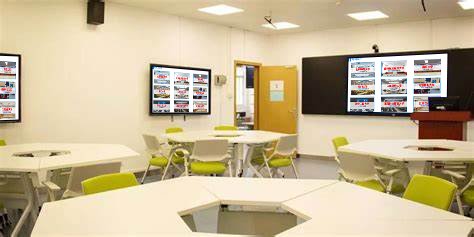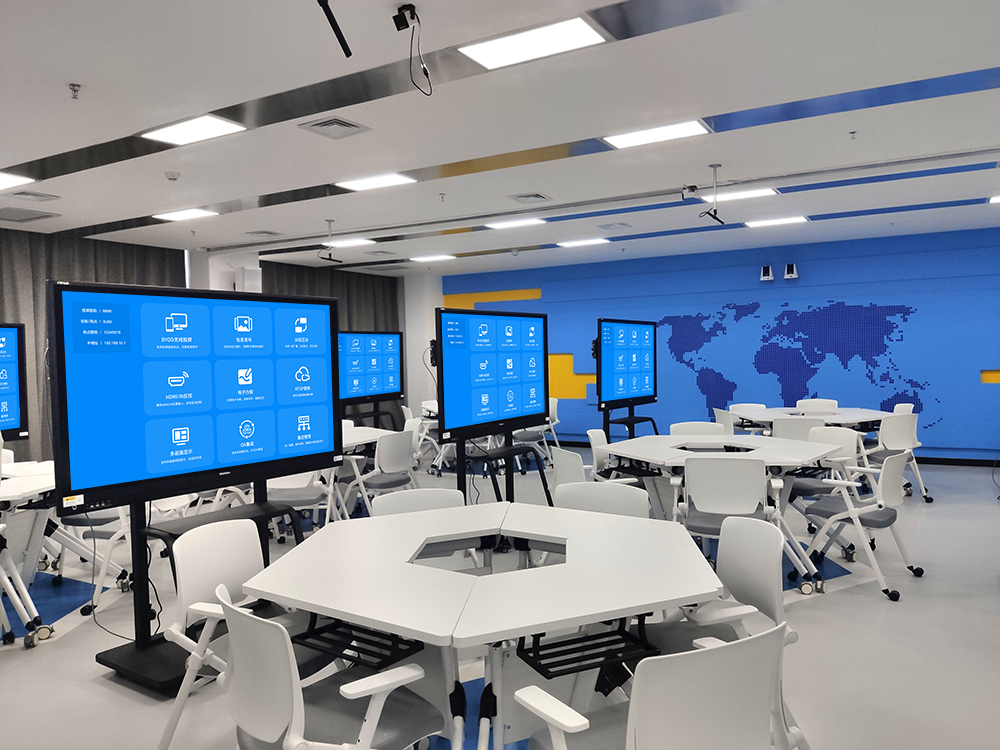Interactive Classrooms: Making the Classroom a Space for Intellectual Collision
With technology as its link, the interactive classroom transforms the traditional “teacher-led” lecture into a two-way space of “teacher-student co-creation.” Here, knowledge is no longer static text but a dynamic energy flowing through questions, demonstrations, and collaboration. Every student’s idea can be seen, and every opinion can spark a new insight.
I. All-Device Interaction Network: Enabling Borderless Content Transfer
The classroom’s main screen, phones, tablets, and computers form a “wireless interaction network,” supporting multi-device connections and bidirectional content flow. A teacher’s courseware can be mirrored from a computer to the main screen, a student’s problem-solving steps can be pushed from a tablet to a group screen, and an experiment filmed on a phone can be mirrored in real-time to the large screen for the whole class to observe. In a 60-person classroom, 8 devices can be online simultaneously, with display switching taking just 1 second. In a math class, the teacher can mirror a function graph from a computer, and students can annotate key points on tablets. Annotations from different students are superimposed on the main screen, instantly visualizing abstract concepts.
(I) Seamless Cross-System Collaboration
Whether it’s handwritten annotations on iOS, incorrect answer collections on Android, or dynamic presentations on Windows, all can run smoothly on the same platform. In an art class, a watercolor painting drawn on an Apple tablet and a photo of an object taken with an Android phone can be compared in a split-screen view on the main display. In an English class, the teacher can play listening material from a MacBook, while students submit dictation answers on Windows computers, and the system automatically tallies the accuracy rate and flags frequent errors, ensuring device differences do not disrupt the teaching rhythm.
(II) Offline Mode Ensures Teaching Continuity
When the internet is down, the system automatically switches to a local hotspot. Teachers mirroring courseware from their phones and students answering questions on their tablets are unaffected. In a class with a sudden network failure, teaching can proceed as usual. During an outdoor sketching class, student artwork filmed on phones can be connected to a portable projector for display, taking the learning experience beyond the classroom walls.
II. Real-Time Interactive Features: Ensuring Every Student Is a Protagonist
(I) Dynamic Feedback System
After a teacher initiates multiple-choice, fill-in-the-blank, or handwritten questions, students answer on their devices, and a data dashboard is generated on the main screen in 3 seconds. It shows the accuracy rate, distribution of incorrect options, and displays of excellent answers. In a Chinese language translation class, for a question on the usage of function words with a 70% error rate, the teacher can immediately pull up a sentence analysis from a database to project and annotate the changes in parts of speech. In a physics circuit experiment, the connection schemes submitted by students can be displayed in a carousel on the large screen, and the teacher can use a red pen to annotate safety hazards, making explanations more targeted and precise.
(II) Collaborative Annotation and Outcome Co-creation
During group discussions, members use different colored pens to annotate their viewpoints on the mirrored content, and the group leader can integrate them into a mind map with one click. For whole-class sharing, the results from 6 groups are presented in a split-screen layout on the main screen. The teacher can use a stylus to circle common issues, with annotations synchronizing to all student devices. In a history class analyzing the “pros and cons of reform,” the arguments from each group collide on the large screen, ultimately forming a multi-dimensional analysis framework. When a class plans an event, members use different colors to annotate feasible suggestions, creating an actionable plan in 1 hour, improving efficiency by 3 times compared to traditional discussions.
III. Scenario-Based Interactive Design: Making Learning Tangible
(I) Science Lab Classes: Visualized Inquiry
Students can use tablets to film an experiment, mirror it to a group screen, and annotate key steps. The teacher can pull up each group’s footage on the main screen to provide feedback. In a chemistry experiment on acid-base reactions, one group’s filmed observation of a “delayed color change” can be pushed to the main screen, sparking a whole-class discussion on reaction rates. An experimental error becomes an opportunity for inquiry, not just a failed result.
(II) Humanities Debate Classes: Clash of Ideas
Pro and con sides upload arguments in real-time from tablets, and the main screen displays their clashing viewpoints in a tree structure. The teacher can annotate logical flaws. During the debate, students can add new arguments from their phones, and the main screen automatically updates the tree. The final “debate mind map” can be reviewed after class, allowing logical thinking skills to naturally grow through practical experience.
(III) Cross-Class Synchronized Lessons: Borderless Resource Flow
Urban and rural schools can connect via the system. The urban teacher’s main screen content synchronizes to the rural classroom, and rural students’ answer data provides real-time feedback. In a music class, a melody played on a piano by an urban student and a piece played on a flute by a rural student can be synchronized on dual main screens, allowing artistic resonance to break through geographical limitations.
IV. Data Consolidation and Review: For Continuous Teaching Optimization
Classroom interaction data is automatically saved to the cloud, including accuracy rates, frequently used annotation words, and group collaboration duration. By analyzing this data, teachers can pinpoint students’ knowledge weak points. If the error rate for a certain type of question exceeds 60% for 3 consecutive classes, the system automatically pushes related micro-lesson resources. Parents can view their child’s classroom interaction records to clearly understand their participation level and thought processes, making their communication more targeted.
The core of an interactive classroom is not for technology to replace the teacher but for tools to amplify the warmth of education. When teachers transform from “knowledge carriers” into “guides of thought,” and students from “passive listeners” into “active explorers,” the classroom truly becomes fertile ground for cultivating wisdom.